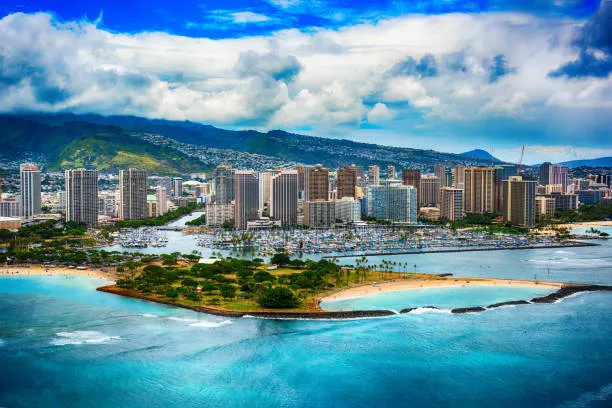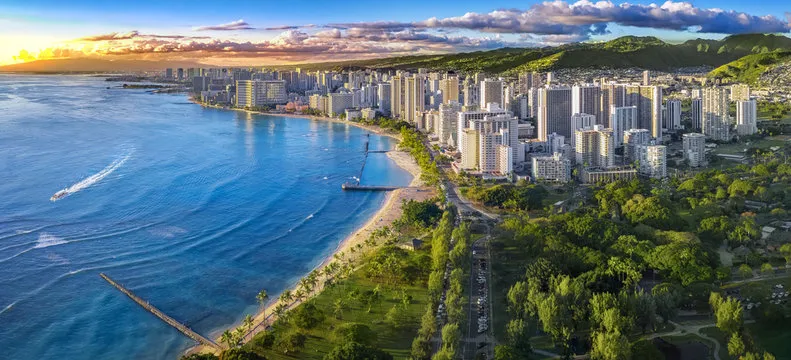Table of Contents
When people think of Hawaii, they often imagine swaying palms, white sand beaches, and volcanic landscapes. But another breathtaking sight that visitors and locals alike admire is the Hawaii skyline. Unlike the towering skyscraper silhouettes of New York or Los Angeles, Hawaii’s skyline tells a unique story—one where natural beauty, history, and urban development coexist in harmony. From the vibrant cityscape of Honolulu to the dramatic mountain ranges that serve as a backdrop, the skyline of Hawaii is one of the most distinctive in the world.
Honolulu: The Heart of Hawaii’s Skyline
The most recognized skyline in the Hawaiian Islands belongs to Honolulu, the capital city located on Oʻahu. Honolulu is the economic and cultural hub of Hawaii, home to high-rise hotels, luxury condominiums, and office buildings that stretch skyward against a turquoise ocean backdrop.
Waikīkī, perhaps the most famous neighborhood of Honolulu, features a dense cluster of hotels and resorts. From the beach, the skyline looks like a vertical cityscape perched right on the edge of the Pacific Ocean. At sunset, the sight is particularly enchanting as golden light reflects off the glass windows of tall buildings, creating a warm glow.
What makes Honolulu’s skyline unique is its harmony with the surrounding natural features. The looming presence of Diamond Head Crater to the east provides a natural frame that contrasts with the manmade structures. Few cities in the world boast such a dramatic juxtaposition of volcanic landscapes with urban design.
The Influence of Mountains and Volcanic Formations
Unlike other metropolitan skylines, Hawaii’s city silhouettes are rarely uninterrupted lines of steel and glass. Instead, they are deeply influenced by the islands’ volcanic origins. The Koʻolau Mountain Range rises sharply behind Honolulu, creating a dramatic green wall that defines the horizon. On Maui, the slopes of Haleakalā tower above towns and resorts, reminding viewers that nature remains the dominant force shaping the skyline.

This connection to the natural environment ensures that Hawaii’s skylines always maintain a sense of balance. Development is visible, but it never overshadows the mountains, cliffs, and craters that define the islands. Even when high-rises are built, strict zoning laws help prevent overdevelopment in certain areas, allowing the natural skyline to remain a focal point.
Skyline by the Islands
While Honolulu stands out as the most urbanized skyline in Hawaii, each island offers its own unique horizon worth admiring:
- Oʻahu – The bustling skyline of Waikīkī and downtown Honolulu is iconic, combining urban density with the grandeur of Diamond Head and the Koʻolau Mountains.
- Maui – Instead of high-rises, Maui’s skyline is defined by natural features like Haleakalā, which dominates the landscape, and the West Maui Mountains that rise sharply above Lahaina and Kāʻanapali.
- Hawaiʻi Island (Big Island) – The Big Island’s skyline is shaped by volcanic activity. Mauna Kea and Mauna Loa, two of the tallest mountains in the world when measured from their base, tower over the island. Towns like Kailua-Kona and Hilo have low-rise skylines, making the vast volcanic peaks the true stars.
- Kauaʻi – Known as the “Garden Isle,” Kauaʻi’s skyline is largely free of tall buildings. Instead, it is defined by lush valleys, jagged cliffs such as the Nā Pali Coast, and towering peaks like Mount Waiʻaleʻale.
- Molokaʻi and Lānaʻi – These islands maintain rural and less-developed skylines. Small towns and open spaces dominate, giving the horizon a timeless, unspoiled look.
The Skyline at Different Times of Day
Hawaii’s skyline changes dramatically with the light.
- Sunrise paints the mountains and clouds in hues of pink and orange, while the buildings of Honolulu reflect the soft morning glow.
- Midday brings bright contrasts, with sharp outlines of the city set against the deep blue Pacific.
- Sunset is perhaps the most celebrated time, as the skyline appears silhouetted against a glowing sky of fiery reds and purples.
- Nighttime reveals a sparkling cityscape. Honolulu, in particular, glimmers with thousands of lights, reflecting off the water and creating a tropical version of the “city that never sleeps.”

A Skyline Shaped by Culture and Sustainability
Hawaii’s skyline is more than just a visual landmark—it’s also a reflection of the islands’ values. Hawaiian culture emphasizes respect for the land, known as mālama ʻāina, which influences how cities are designed and built. For example, many high-rises incorporate open-air designs and green spaces to connect urban living with the natural world.
In recent years, sustainable architecture has become a growing focus. New developments in Honolulu and other areas are prioritizing energy efficiency, solar integration, and eco-friendly materials. This approach ensures that while the skyline grows, it does so in a way that aligns with Hawaii’s commitment to protecting its environment.
The Hawaii skyline is a unique blend of manmade structures and natural wonders. While Honolulu offers the most recognizable cityscape, the skylines across the islands highlight volcanic peaks, lush mountain ranges, and dramatic coastlines that make Hawaii unlike anywhere else. Whether admired at dawn, dusk, or under a canopy of stars, the skyline here tells the story of a place where urban life and natural beauty coexist in harmony.
For visitors, the Hawaii skyline is more than just a backdrop—it’s a reminder of the islands’ delicate balance between progress and preservation, culture and modernity, earth and sky.
Helpful Resources on Hawaii and its Skyline
- Hawai‘i Tourism Authority
- Go Hawaii – Official Travel Site
- City and County of Honolulu
- Hawai‘i State Parks
- National Park Service – Hawai‘i
Frequently Asked Questions
1. What makes the Hawaii skyline different from other city skylines in the world?
The Hawaii skyline is unique because it blends modern high-rises with dramatic natural landmarks like volcanic craters, lush mountains, and ocean views. Unlike cities dominated by steel and glass, Hawaii’s skyline showcases harmony between urban development and the islands’ incredible natural scenery. It’s a place where skyscrapers sit next to coral-blue waters and are framed by towering mountains.
2. Which island has the most famous and recognizable skyline in Hawaii?
The most iconic skyline belongs to Honolulu on Oʻahu. Known for its high-rise hotels, luxury condos, and the bustling Waikīkī district, Honolulu features the most urban skyline in the islands. What makes it stand out is its backdrop: Diamond Head Crater and the towering Koʻolau Mountains, creating one of the most scenic city-meets-nature skylines on Earth.
3. What does the skyline of Waikīkī look like?
The Waikīkī skyline is a dense cluster of beachfront hotels and resorts rising above the Pacific Ocean. Seen from the sand, it looks like a vertical city perched on the shoreline. At sunset, the buildings glow gold as the light reflects off the windows, creating one of the most photographed views in Hawaii.
4. How do Hawaii’s mountains influence the skyline?
Hawaii’s skyline is shaped heavily by its volcanic mountain ranges, which act as a dramatic natural backdrop.
- In Honolulu, the Koʻolau Mountains rise sharply behind the city.
- On Maui, Haleakalā and the West Maui Mountains dominate the horizon.
- On the Big Island, the massive slopes of Mauna Kea and Mauna Loa define the skyline.
These natural giants ensure that no skyline in Hawaii ever feels disconnected from the environment.
5. What do the skylines on the different Hawaiian Islands look like?
Each island has its own distinct skyline:
- Oʻahu: Urban skyline with Diamond Head and the Koʻolau Mountains.
- Maui: Defined by natural silhouettes like Haleakalā and the West Maui Mountains.
- Hawaiʻi Island: Volcanic peaks like Mauna Kea and Mauna Loa shape the horizon; cities remain low-rise.
- Kauaʻi: Lush, rugged, and mostly untouched; dominated by the Nā Pali Coast and Mount Waiʻaleʻale.
- Molokaʻi & Lānaʻi: Rural, quiet skylines with small towns and open landscapes.
Together, they highlight Hawaii’s diversity.
6. When is the best time of day to admire the Hawaii skyline?
The Hawaii skyline changes beautifully throughout the day:
- Sunrise: Mountains glow pink and orange.
- Midday: Buildings contrast sharply with deep blue ocean and sky.
- Sunset: The skyline becomes a silhouette against vibrant red and purple skies.
- Night: Honolulu sparkles with lights reflecting on the water.
Each time of day offers a new perspective for photography or sightseeing.
7. Why does Honolulu have more skyscrapers than the other Hawaiian islands?
Honolulu is the economic, cultural, and residential hub of Hawaii, making it the only island with a major urban center. Zoning laws and sustainability efforts keep development concentrated to preserve natural landscapes. Other islands limit building heights to ensure mountain views and protect the natural skyline.
8. How do volcanic landscapes contribute to the Hawaii skyline?
Volcanic formations like Diamond Head, Haleakalā, Mauna Kea, Mauna Loa, and the Koʻolau Range create iconic silhouettes that make Hawaii instantly recognizable. These natural structures are millions of years old and provide dramatic contrast to the modern architecture below, giving Hawaii’s skylines a sense of timeless beauty.
9. Are there sustainable or eco-friendly features in Hawaii’s skyline?
Yes. Hawaii is committed to mālama ʻāina—caring for the land. Many new buildings incorporate sustainable design, including solar power, open-air layouts, green spaces, and energy-efficient materials. This approach allows Hawaii to modernize without compromising environmental values.
10. Can you see the Hawaii skyline from the beach?
Absolutely. Some of the best views of the Honolulu and Waikīkī skyline are seen right from the beach. You can admire high-rises framed by calm ocean waves, with Diamond Head anchoring the scene. Maui and Kauaʻi also offer stunning skyline views dominated by mountains instead of buildings.
11. Is the Hawaii skyline good for photography?
Yes—Hawaii’s skyline is a dream for photographers. The blend of urban silhouettes, ocean reflections, volcanic backdrops, and colorful skies makes it one of the most photogenic skylines in the world. Sunrise and sunset are especially breathtaking.
12. What makes the Hawaii skyline meaningful beyond its beauty?
The skyline reflects Hawaii’s values: a balance between progress and preservation, culture and nature. It tells the story of islands shaped by volcanic forces, enriched by Hawaiian heritage, and guided by sustainable planning. Whether viewed at dawn, dusk, or from the ocean, the skyline symbolizes Hawaii’s harmony between city life and natural wonder.
If you would like to read and learn more about interesting things in Hawaii! Check out our blog page here on our website!
or
